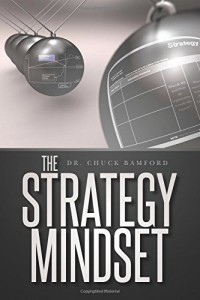7 Corporate Strategy Myths
Dr. Chuck Bamford’s new book, The Strategy Mindset, is a practical guide for creating a corporate strategy. Having read more books on strategy than I can remember, I particularly like this one. As I read the book, there were times I found myself arguing with the author. At other times, I was nodding. Still at other times, I found myself with immediately actionable ideas to improve the process at my own organization. And that’s why I enjoyed the read so much.
I think the most controversial part of his book is likely the myths section, where he takes apart existing myths of corporate strategy.
1. People Are Not A Competitive Advantage
Let’s talk about the myths.
First, you say that people are not a competitive advantage. You argue that almost all employees are interchangeable. Good employees are just “table stakes.” Is it not possible to have employees who, on average, are better than the competition?
It flies in the face of so many beliefs that it is just hard to accept. Employees are VERY important as the way that business delivers to customers. However, the moment that you actually believe that your employees are smarter than your competitors’ is the moment that your competitors will start beating you in the market. You have the same (or relatively the same) collection of amazing employees, capable employees, and poor employees as your competitors. All the HR processes in the world today have not changed that dynamic in companies. The employees that you have working in your company are a combination of luck (the biggest factor), HR practices, networking, and did I mention luck!
 I’m not trying to be divisive here, but most of your customers do not generally care (or if they care at all, it is slight) who takes care of their business needs as long as the needs are taken care of. This does not apply to every employee in a company, just most. At every company I have ever worked with or for, there is a contingent of “franchise” employees. Those are employees who, if they left the company, would impact the success of that company quite substantially. We all know who these folks are, and if executives are smart, they take care of these employees to ensure that they stay with the organization. These “franchise” employees are not just the customer-facing employees; they reside throughout an organization.
I’m not trying to be divisive here, but most of your customers do not generally care (or if they care at all, it is slight) who takes care of their business needs as long as the needs are taken care of. This does not apply to every employee in a company, just most. At every company I have ever worked with or for, there is a contingent of “franchise” employees. Those are employees who, if they left the company, would impact the success of that company quite substantially. We all know who these folks are, and if executives are smart, they take care of these employees to ensure that they stay with the organization. These “franchise” employees are not just the customer-facing employees; they reside throughout an organization.
2. SWOT is NOT Strategy
Second, you are not a fan of the SWOT. What’s wrong with the way most organizations use it?
SWOT is the single biggest impediment to doing real strategy that exists, and it exists because certain big consulting firms continue to use it with their clients, and it makes clients “feel good” without really having to do strategy.
SWOT was an attempt to bring some structure to the topic, and as a conceptual approach, it is still fairly robust. Unfortunately, many authors, academics, and practitioners decided that SWOT was an analysis tool and a means for a company to develop its strategy. SWOT is NOT strategy, and it is not an analysis tool.
Anyone can create a SWOT. It is grounded in your own biases and view of the world. In the end, a SWOT is simply the opinion of the person or group filling it out.
Do you want to know the strengths of your company? Of course you do. There are well-honed techniques available for getting at the true strengths (differentiators) of your company. It only matters if it helps separate your business from your competitors in the eyes of the customer.
Do you want to know the weaknesses of your company? Of course you do. These are the standard elements of the business that are being operated below the median expectations in the industry. It’s a weakness if it impacts your customers and prevents them from considering your true strengths.
Do you want to know the opportunities of your company? Of course you do. However, it is only an opportunity if you have a competitive advantage that can be applied to it. There are a number of fantastic techniques for crafting these opportunities.
Do you want to know the threats to your company? Of course you do. However, threats affect most of the companies in your industry. Therefore, there are a number of approaches to discern what these might be and how a company can navigate those ahead of its competitors.
What does this mean? It means that it is time to put SWOT to bed as a strategy approach. It is time for every businessperson to learn how to really develop strategy and how it can be implemented.
Don’t do SWOT!
3. Product Life Cycle Strategy is a Waste of Time
Third, you say the product life cycle strategy exists, but it is a waste of time. Why?
The product life cycle (PLC) most certainly exists, and it is quite interesting to view the pattern over time with virtually every product or service. The theory (according to the marketing folks) is that if you know where you are in the life cycle, then you know how to invest your resources. All of that would be fine if we had any idea where we were in the life cycle while we were actually in it—which we do not.
You know where you are in the life cycle only long after the product or service has ceased to be of practical value. PLC works very well as a historical observation and is simply useless as a tool for understanding current or future strategic approaches.
Strategy is about making decisions that will impact the company in the future.
7 Myths of Corporate Strategy
1: My people are my competitive advantage.
2: SWOT analysis will allow us to develop a strategy.
3: The product life cycle will help me decide on a strategy.
4: We shouldn’t look at what competitors are doing – let’s focus on what we do.
5: Quality or customer service is our strategic advantage.
6: Low cost is the key to our strategy.
7: Our brand is our strategy.
4. There Is No Need to Look at What Competitors Are Doing
Fourth, you debunk the idea that we should not look at competitors and only look at our own strategy. Why is competitive benchmarking and understanding not given the attention you say it deserves?
GREAT Question. Here’s one that somehow made it into the lore of exceptional business leadership. If you follow some of the interviews that have been broadcast over the years, you will find some leaders who insist that they pay no attention to competitors, as though that somehow made their successes more impressive.
It is hard to find a way to support this approach even on its face when we know that customers compare any product or service we offer to other alternatives. While we may have a core group of dedicated, loyal customers who will never consider the competition, this group of “perfect customers” is rarely big enough to allow a business to grow.
Customers compare every offering, every product, and every aspect of a business not only to your direct competitors but also to other means of achieving a similar result.
We simply must know what our competitors are doing, how they are doing it, and how that might impact our sales. A deep understanding of the competitors is the first step in designing a strategy.
5. Customer Service is Table Stakes
Fifth, you are wary of customer service as a strategy. Why?
It is shocking how many companies seem to truly believe that their strategy revolves around customer service. It is what differentiates us in the market! The drumbeat of customer service as our strategic differentiator is used by virtually every company. While it is certainly politically correct, this one is so far from being true that it is laughable.
Now let’s be clear—it would be wonderful if customer service were really the cornerstone of a business. The entire business would be focused on the needs of the customer, and each customer would feel that he or she was truly important to the company. The customer would bypass your competitors in order to enjoy the feeling that he or she had when doing business with your company.
When was the last time you felt that way at your bank, gas station, cleaner’s, utility, fast-food restaurant, lawyer, doctor, university, or other organization? The answer is not much and not consistently. A basic tenet of strategy is that whatever constitutes the elements of your competitive advantages must be consistently seen by the customer.
For the vast majority of companies, customer service is just table stakes. It is one of those areas where the company needs to be within a reasonable distance of the average for the industry (actually measured as the median by strategists). Some industries have a very high median level of expected customer service, while others are simply abysmal.
A lot of money spent beefing up what passes for customer service is only of value if the company can achieve a level of service that is so far above the competitors that customers truly notice the difference. Otherwise, it is a waste of time, money, and resources to do much more than what is expected in your industry. In other words, customer service is only rarely a strategy; mostly it consists of empty words into which companies pour money.
6. Low Cost is Rarely a Strategy
Sixth, cost-cutting is not the answer either. What is the problem with this strategy?
Virtually every company at some point in its existence has had an executive convince the senior leadership team that cost cutting is a strategy. Top lines are not growing as hoped; competition is getting tougher, and bonuses are being cut. Executives are convinced that the company can attain a competitive advantage by making Herculean efforts to lower costs (or at least earn their bonuses in the short run—probably the real reason).
Interestingly enough, this is absolutely true—for one company in your competitive set. While cost containment is generally advisable as a tactic (as long as it does not impact the strategy being pursued by the company), only one company in any particular industry can actually be the low-cost leader. Everyone else is simply a wannabe without the ability to attain the same basis-point margins as the low-cost leader. The true low-cost leader can lower prices to the point where competitors are simply not profitable (think the PC industry) while still maintaining healthy margins.
Cost cutting is a tactic that should appropriately be applied to any element of the business that is considered table stakes in the industry. You should apply all the well-known techniques for efficiency to those areas of the business that are not true competitive advantages of the organization.
There is a big difference between low cost and low price. In every industry and in every product or service offering, there are a group of customers that will only buy from you if you are the low-price leader. Chasing these customers is intelligent only if you are the low-cost leader.
Anyone can be the low-price leader as long as they are willing to sacrifice margins. Competing to be the low-price alternative is a strategic spiral to mediocrity at best and bankruptcy at worst, unless you really are the low-cost leader at the same time.
So, low cost can indeed be a strategy—for one organization in each industry. It can be incredibly effective for that one company, but it is only for one company. Every other company in an industry needs a real strategy (a set of true competitive advantages) that will be the focus of everyone in the company.
7. Brand is Not A Competitive Advantage
Myth 7: Brand is not a strategy. What is this myth and why do many get this wrong?
Brands are incredibly powerful symbols for both employees and customers. A well-crafted brand image can certainly draw in customers while allowing the company to charge a premium price. However, a brand is not a strategy. It is what makes up (creates) that brand that is the strategy. Every company has a brand, and we have seen brands come and go over the years. A brand like Sony was the pinnacle of technological innovation and cachet in the 1990s at a time when Apple was considered a niche player in the computer field. The names have not changed significantly (albeit Apple moved away from Apple Computer), and yet the “brand” is completely different. Sears was the go-to store for decades and is now fighting for survival. This ebb and flow of brands happens all the time.
It is important to understand that a brand has no value without a strong set of competitive advantages supporting it. As companies fail to continuously design and effectively implement real strategies, the brand loses value. Fortunately, for most brands, this decline is gradual, as customers have institutional memory. This provides a continuous window within which company executives can develop real strategies that truly separate the company from its competitors and then tie those elements to the brand.
The Strategy Mindset

